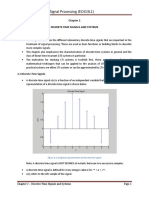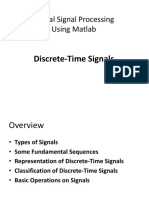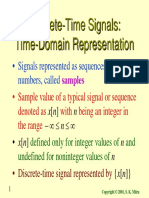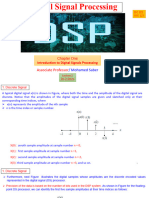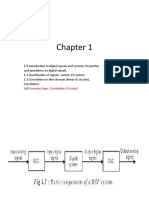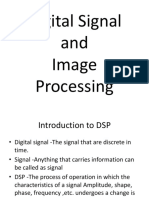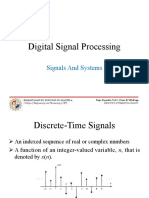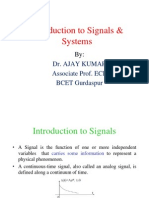0% found this document useful (0 votes)
65 views26 pagesSignal Spectra and Signal Processing (SSPL01E) Digital Signal Processing (SSPL01E) Eng'r Rianne Arne S. Reyes
This document discusses discrete-time signals and basic signal processing operations. It defines discrete-time signals as sequences of real or complex numbers indexed by the integer n. Common representations include functional, tabular, and sequence representations. Elementary discrete signals include unit sample sequences, unit step signals, unit ramp signals, and exponential signals. Signals can be classified as periodic, aperiodic, symmetric, or antisymmetric. Basic operations include time shifting, reversal, time scaling, amplitude scaling, addition, and multiplication.
Uploaded by
cold keyboardCopyright
© © All Rights Reserved
We take content rights seriously. If you suspect this is your content, claim it here.
Available Formats
Download as PDF, TXT or read online on Scribd
0% found this document useful (0 votes)
65 views26 pagesSignal Spectra and Signal Processing (SSPL01E) Digital Signal Processing (SSPL01E) Eng'r Rianne Arne S. Reyes
This document discusses discrete-time signals and basic signal processing operations. It defines discrete-time signals as sequences of real or complex numbers indexed by the integer n. Common representations include functional, tabular, and sequence representations. Elementary discrete signals include unit sample sequences, unit step signals, unit ramp signals, and exponential signals. Signals can be classified as periodic, aperiodic, symmetric, or antisymmetric. Basic operations include time shifting, reversal, time scaling, amplitude scaling, addition, and multiplication.
Uploaded by
cold keyboardCopyright
© © All Rights Reserved
We take content rights seriously. If you suspect this is your content, claim it here.
Available Formats
Download as PDF, TXT or read online on Scribd
/ 26





